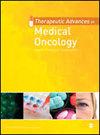提高疗效:艾瑞布林、安罗替尼和坎雷珠单抗联合治疗晚期或转移性腹膜后脂肪肉瘤。
IF 4.2
2区 医学
Q2 ONCOLOGY
引用次数: 0
摘要
背景腹膜后脂肪肉瘤(RLPS)通常对标准化疗的反应有限,这给晚期或转移性RLPS的治疗带来了挑战。本研究旨在评估埃瑞布林、安罗替尼和坎瑞珠单抗联合治疗策略的潜在优势。治疗方案包括埃瑞布林+安罗替尼和坎瑞珠单抗,每3周给药(Q3W)。方法根据实体瘤反应评价标准1.1版评估疗效,根据不良事件通用术语标准5.0版评估安全性。患者接受了中位数为 4.5 个周期(2-21 个周期)的治疗。值得注意的是,8 名患者(18.2%)出现部分反应,25 名患者(56.8%)病情稳定。客观反应率(ORR)和疾病控制率分别为 18.2% 和 75%。组织学亚型之间的 ORR 有显著差异(分化良好 vs 去分化 vs 类肌瘤:0 vs 17.9% vs 50%;分化良好 vs 去分化 vs 类肌瘤:0 vs 17.9% vs 50%):0 vs 17.9% vs 50%; p = 0.039)。六名患者在疾病进展前接受了手术,一名肌样脂肪肉瘤(MLPS)患者获得了病理完全反应。中位随访时间为21.8个月(2.7-30.7个月),中位无进展生存期(mPFS)为6.9个月(95%置信区间(CI)为4.7-9.1个月),6个月PFS率为60.5%。根据不同的组织学亚型,分化良好的脂肪肉瘤的mPFS分别为8.4个月(95% CI,4.1-12.7个月),去分化脂肪肉瘤为5.8个月(95% CI,3.3-8.3个月),而MLPS则未达到这一水平。36例(76.6%)患者发生了任何级别的治疗相关不良事件(TRAEs),21例(44.7%)患者发生了3级或更高级别的TRAEs。最常见的不良反应是中性粒细胞减少(53.2%)、蛋白尿(21.3%)和厌食(21.3%)。结论艾瑞布林、安罗替尼和坎雷珠单抗的联合治疗策略在晚期或转移性RLPS患者,尤其是MLPS患者中显示出良好的疗效和可控的安全性。本文章由计算机程序翻译,如有差异,请以英文原文为准。
Advancing treatment efficacy: combined therapy of eribulin, anlotinib, and camrelizumab in advanced or metastatic retroperitoneal liposarcoma.
Background
Retroperitoneal liposarcoma (RLPS) typically shows limited response to standard chemotherapy, presenting a challenge in treating advanced or metastatic RLPS.
Objective
This study aimed to evaluate the potential advantages of a combined therapeutic strategy utilizing eribulin, anlotinib, and camrelizumab.
Design
Between December 2020 and March 2023, this retrospective study enrolled patients with advanced or metastatic RLPS who received treatment at Peking University Cancer Hospital Sarcoma Center. The treatment regimen involved eribulin plus anlotinib and camrelizumab administered every 3 weeks (Q3W).
Methods
Efficacy was assessed following the Response Evaluation Criteria in Solid Tumors version 1.1, while safety was evaluated using the Common Terminology Criteria for Adverse Events version 5.0.
Results
The study included 47 patients with RLPS with a median age of 55.5 years. Patients received a median of 4.5 (range, 2-21) cycles of treatment. Notably, partial response was observed in 8 patients (18.2%), while 25 (56.8%) exhibited stable disease. The objective response rate (ORR) and disease control rate were 18.2% and 75%, respectively. Significant differences in ORR were observed among histological subtypes (well-differentiated vs de-differentiated vs myxoid: 0 vs 17.9% vs 50%; p = 0.039). Six patients underwent surgery before disease progression, and one patient with myxoid liposarcoma (MLPS) had a pathological complete response. With a median follow-up of 21.8 (range, 2.7-30.7) months, the median progression-free survival (mPFS) was 6.9 (95% confidence interval (CI), 4.7-9.1) months, and the 6-month PFS rate was 60.5%. Based on various histological subtypes, the mPFS was 8.4 (95% CI, 4.1-12.7) months with well-differentiated liposarcoma, 5.8 (95% CI, 3.3-8.3) months with de-differentiated liposarcoma and not reached with MLPS, respectively. Treatment-related adverse events (TRAEs) of any grade occurred in 36 (76.6%) patients, with grade 3 or higher TRAEs in 21 (44.7%) patients. The most common TRAEs were neutropenia (53.2%), proteinuria (21.3%), and anorexia (21.3%).
Conclusion
The combined treatment strategy involving eribulin, anlotinib, and camrelizumab showed promising efficacy and manageable safety in patients with advanced or metastatic RLPS, particularly in those with MLPS.
求助全文
通过发布文献求助,成功后即可免费获取论文全文。
去求助
来源期刊

Therapeutic Advances in Medical Oncology
ONCOLOGY-
CiteScore
8.20
自引率
2.00%
发文量
160
审稿时长
15 weeks
期刊介绍:
Therapeutic Advances in Medical Oncology is an open access, peer-reviewed journal delivering the highest quality articles, reviews, and scholarly comment on pioneering efforts and innovative studies in the medical treatment of cancer. The journal has a strong clinical and pharmacological focus and is aimed at clinicians and researchers in medical oncology, providing a forum in print and online for publishing the highest quality articles in this area. This journal is a member of the Committee on Publication Ethics (COPE).
 求助内容:
求助内容: 应助结果提醒方式:
应助结果提醒方式:


